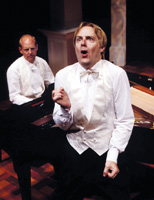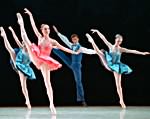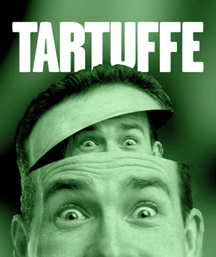
TIMES THEATRE TRIBUTES--2003
Greater Cleveland is blessed with a vital theatre scene. It is the purpose of the TIMES THEATRE TRIBUTES to recognize theatrical experiences that, in the mind of this reviewer, were excellent.
No attempt is made to name the best in each classification. Actors were not separated by gender or leading or supporting roles. It is also recognized that I did not see all of the productions in the area, so only shows performed in 2003 that I reviewed were considered. Selections are limited to locally produced performances, so none of the professional touring shows are recognized, though actors, directors and technicians who were imported by local theatres were considered.
Thanks to the following for making the theatre scene in the Cleveland area vital and exciting.
PRODUCTIONS
‘ARMS AND THE MAN’--Great Lakes Theatre Festival
‘BAT BOY’--Cain Park
‘BOY GETS GIRL’---Beck
‘CHERRY DOCS’--Halle/JCC
‘DIRTY BLONDE’--Cleveland Play House
‘FIDDLER ON THE ROOF’--Cain Park
‘FRANKIE AND JOHNNY IN THE CLAIR DE LUNE’--Ensemble
‘IN THE BLOOD’--Dobama
‘THE CHOSEN’--Halle/JCC
‘THE DOMINO HEART’----Dobama
‘THE FIX’---Beck
DIRECTING
Victoria Bussert--ANYTHING GOES--Great Lakes Theatre Festival
Victoria Bussert--BAT BOY--Cain Park
Joyce Casey--THE DOMINO HEART--Dobama
Licia Colombi--‘FRANKIE AND JOHNNY IN THE CLAIR DE LUNE’--Ensemble
Charles Fee--ARMS AND THE MAN--Great Lakes Theatre Festival
Seth Gordon--PROOF--Cleveland Play House
Peter Hackett--DIRTY BLONDE--Cleveland Play House
Sarah May--BOY GETS GIRL--Beck
Sonya Robbins--IN THE BLOOD--Dobama
Dorothy Silver---THE CHOSEN--Halle/JCC
Reuben Silver--CHERRY DOCS--Halle/JCC
Clyde Simon--SINCERELY YOURS--convergence-continuum
Scott Spence--THE FIX--Beck
Fred Sternfeld--FIDDLER ON THE ROOF--Cain Park
PERFORMANCE
MaryAnn Black--OKLAHOMA--Porthouse
Adina Bloom--BAT BOY--Cain Park
Sean Booker--SIX DEGREES OF SEPARATION--Charenton Theatre
Lucy Bredeson-Smith--PICNIC--Actors’ Summit
Sherri Britton--THE CREDEAUX CANVAS--Ensemble
Toni Cervino--INTO THE WOODS--Lakeland College
Meg Chamberlain--MRS. BOB CRATCHIT’S WILD CHRISTMAS BINGE--Cleveland Public Theatre
Glenn Colerider--THE DOMINO HEART--Dobama
Rosario Costanzo--OKLAHOMA--Porthouse
Nina Domingue--SINCERELY YOURS--convergence-continuum
Cody Dove--Second City-Cleveland
Carla Dunlavey--THE DOMINO HEART--Dobama
Sean Fitzgerald--KIMBERLY AKIMBO--Dobama
Paul Floriano--THE FIX--Beck
Dan Folino--THE FIX--Beck
Margaret Ford-Taylor--FOREST CITY--Cleveland Play House
Tom Frey--DIRTY BLONDE--Cleveland Play House
Tom Fulton----TARTUFFE--Actors’ Summit
Tom Fulton--FIDDLER ON THE ROOF--Cain Park
Paul Kaiser--BOY GETS GIRL--Beck
Charles Kartali--FRANKIE AND JOHNNY IN THE CLAIR DE LUNE--Ensemble
Julia Kolibab--‘FRANKIE AND JOHNNY IN THE CLAIR DE LUNE--Ensemble
Kayce L. Cummings--OKLAHOMA--Porthouse
Andrew May--TARTUFFE--Great Lakes Theatre Festival
Rasheryl McCreary--IN THE BLOOD--Dobama
Elizabeth Meadows Rouse--DIRTY BLONDE--Cleveland Play House
Lara Mielcarek--EACH DAY DIES WITH SLEEP--convergence-continuum
Mitch McCarrel--BAT BOY--Cain Park
Laura Perrotta--ARMS AND THE MAN--Great Lakes Theatre Festival
Scott Plate--CHERRY DOCS--Halle/JCC
Derdriu Ring--PROOF--Cleveland Play House
Trinidad Rosado--RAGTIME--Cassidy Theatre
Rhoda Rosen--V-E DAY--Dobama
Steve Routman--ANYTHING GOES--Great Lakes Theatre Festival
Geoffrey Short--RAGTIME--Cassidy
Reuben Silver--THE CHOSEN--Halle/JCC
Sean Szaller--THE CHOSEN--Halle/JCC
Kristopher Thompson-Bolden--A CHORUS LINE--Porthouse
Elizabeth Ann Townsend--BOY GETS GIRL--Beck
Wayne Turney--HAMLET--Great Lakes Theatre Festival
Eric van Baars--OKLAHOMA--Porthouse
Greg Violand--1776--Beck
Greg Violand--LA CAGES AUX FOILES--Beck
Gary Walker--A CHORUS LINE--Porthouse
Gary Walker--BAT BOY--Cain Park
Ensemble performance--Rasheryl McCreary, Victor Dickerson, Anthony Elfonzia, Renee Matthews-Jackson, Kevin Brewer and Cassandra Vincent--IN THE BLOOD--Dobama
Ensemble Performance--Gary Walker, Adina Bloom, Scott Plate, Emily Krieger, Patrick Janson, Phillip Carroll, Alana Simone Purvis, Hannah Laird, Fabio Polanco and Mitch McCarrell--BAT BOY--Cain Park
TECHNICAL
Michael Ganio--scenic design--PROOF--Cleveland Play House
Larry Gorjup--sound design--THE CHOSEN--Halle/JCC
Corby Grubb’s sound design--FRANKIE AND JOHNNY IN THE CLAIR DE LUNE-- Ensemble
Jeff Herrmann--lighting design--FIDDLER ON THE ROOF--Cain Park
Jeff Herrmann--scenic design--FIDDLER ON THE ROOF--Cain Park
Jeff Herrmann--scenic design--THE TALE OF THE ALLERGIST’S WIFE --Dobama
Andrew Kaletta--lighting design--IN THE BLOOD--Dobama
Tony Kovacic-- scenic design--CHERRY DOCS--Halle/JCC
Todd Krispinsky--scenic design--IN THE BLOOD-Dobama
Don McBride--scenic design--BOY GETS GIRL--Beck
Don McBride--scenic design--THE FIX--Beck
Vincent Polowy--lighting design--THE CREDEAUX CANVAS--Ensemble
MUSICAL DIRECTION
Leonard DiCosimo--musical direction--BAT BOY--Cain Park
Larry Goodpaster--musical direction--THE FIX--Beck
Steven Gross--musical direction--ANYTHING GOES--Great Lakes Theatre Festival
Larry Hartzell--musical direction--FIDDLER ON THE ROOF--Cain Park
CHOREOGRAPHER
MaryAnn Black--choreography--A CHORUS LINE--Porthouse
Martin Cepedes--choreography--JOSEPH--Beck
John R. Crawford--choreography--OKLAHOMA--Porthouse
Janiece Kelley-Kiteley--choreography--BAT BOY--Cain Park
Janet Watson--choreography--ANYTHING GOES--Great Lakes Theatre Festival
Eric van Baars--choreography--FIDDLER ON THE ROOF--Cain Park
OTHER
Wayne S. Turney--Script adaptation--TARTUFFE--Actors’ Summit
Beck Center--outstanding variety of productions
Cleveland Public Theatre--Black Box Theatre--creative use of performance space
Bill Ransom--original music--IN THE BLOOD--Dobama



























